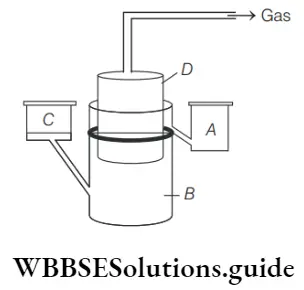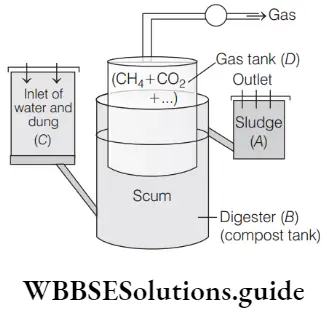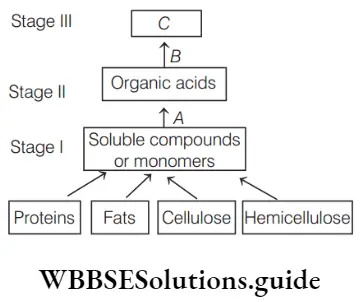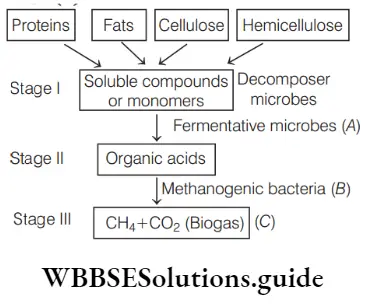Biology MCQ For NEET With Answers Microbes In The Production Of Biogas
Question 1. Biogas production from waste biomass with the help of methanogenic bacteria is
- Multi steps process
- One-step process
- Two steps process
- Three steps process
Answer: 4. Three steps process
Biogas is methane-rich fuel gas produced by the anaerobic breakdown of biomass by methanogenic bacteria. It is a three steps process.
Question 2. Both power and manure are provided by
- Biogas plant
- Distillation plant
- Sugar processing plant
- Nuclear plant
Answer: 1. Biogas plant
Biogas is used as fuel for heating cooking and lighting. Slurry remaining after the production of biogas can be used as fertilizers
Read And Learn More: NEET Biology Multiple Choice Question And Answers
Question 3. The first step in biogas production is
- Generation of methane
- Aerobic breakdown of polymers
- Anaerobic breakdown of polymers
- Conversion of monomers to organic acids
Answer: 3. Anaerobic breakdown of polymers
“microbes in human welfare “
In the first step of biogas production, the polymer, cellulose that is present in the raw material like cow dung, is hydrolyzed to simple compounds anaerobically, i.e. Anaerobic breakdown of polymers.
Question 4. Biogas is ………….. Source of energy.
- Conventional and non-renewable
- Non-conventional and renewable
- Conventional and renewable
- Non-conventional and non-renewable
Answer: 2. Non-conventional and renewable
Biogas is considered to be a renewable and non-conventional resource because its production and use cycle is continuous and it generates no net carbon dioxide.
NEET Biology Microbes in Biogas Production MCQs with answers
Question 5. The main raw material used in biogas production is
- Vegetable waste
- Cow dung
- Agricultural waste
- Domestic waste
Answer: 2. Cow dung
Cattle dung has been recognized as the chief raw material for biogas plants. Other materials like night soil, poultry litter, and agricultural waste are also used.

Important MCQs on Microbes in Biogas Production for NEET
Question 6. Name the group of microbes observed in a biogas plant.
- Lactic acid bacteria
- Cyanobacteria
- Both (1) and (2)
- Methanogens
Answer: 4. Methanogens
Certain bacteria which grow anaerobically on cellulosic material, produce large amounts of methane along with carbon dioxide and hydrogen gas. These bacteria are collectively called methanogens. They are used in biogas plants.
Question 7. Which of the following wastes are used in biogas production?
- Domestic waste, agricultural waste
- Agro waste, municipal waste
- Forestry waste
- Chemical waste
Choose the option containing
- 1 And 4 are used
- 2 And 3 are used
- 1, 2, And 3 are used
- 2 And 4 are used
Answer: 3. 1, 2 And 3 are used
Except for chemical wastes, all the organic waste like domestic, agricultural, municipal, forestry, etc. Waste can all be used in biogas production.
8. The diagram below represents a typical biogas plant. Select the correct option for a, b, c, and d, respectively.

- A–sludge, b–dung+water, c–gas tank, d–outlet
- A–gas tank, b–dung+water, c–sludge, d–inlet
- A–sludge, b–digester, c–an inlet of dung and water, d–gas tank
- A–gas tank, b–sludge, c–dung + water, d–inlet
Answer: 3. A–sludge, b–digester, c–an inlet of dung and water, d–gas tank

NEET quiz on Microbes in Biogas Production with solutions
Question 9. During anaerobic digestion of organic waste, such as in producing biogas, which of the following is not degraded?
- Hemicellulose
- Cellulose
- Lipids
- Lignin
Answer: 4. Lignin
Lignin does not degrade in the production of biogas.
Question 10. Biogas production is an
- Aerobic process
- Anaerobic process
- Active process
- None of the above
Answer: 2. Anaerobic process
“select the correct group of biocontrol agents “
Biogas generation is a three-stage process of anaerobic digestion of animal and other organic wastes by methanogenic bacteria.
Biology MCQ For NEET With Answers
These are.
- Breakdown of polymers.
- Conversion of monomers into organic acids by fermentation of microbes.
- Generation of methane by methanogenic bacteria (conversion of organic acids into ch4 and CO2).
Question 11. In a biogas plant, a mixture of cow dung and water is fed in the ratio of
- 2:1
- 1:1
- 1:2
- 3:1
Answer: 2. 1:1
- The mixture of dung and water which enters the biogas plant in semiliquid form is called ‘undigested slurry.’ It contains cow dung and water in a 1:1 ratio.
- The undigested slurry undergoes a series of anaerobic digestion processes or fermentation in a biogas digester and is converted into a combustible gas called ‘biogas.’
Question 12. The anaerobic digestion of biogas production involves
- Conversion of insoluble polymers to simple soluble monomers
- Conversion of monomers to organic acids
- Conversion of organic acids to methane
- Conversion of monomers to methane
Answer: 1. Conversion of insoluble polymers to simple soluble monomers
Anaerobic digestion is the process by which insoluble polymers of organic matter such as animal or food waste are broken down into simple soluble monomers to produce biogas and biofertiliser. This process happens in the absence of oxygen in a sealed, oxygen-free tank called an anaerobic digester.
NEET expected MCQs on Microbes in Biogas Production 2025
Question 13. For biogas production, besides dung which one of the following weed is recommended in our country?
- Eichhornia crassipes
- Hydrilla
- Mangifera
- Solanum nigrum
Answer: 1. Eichhornia crassipes
Eichhornia crassipes is recommended because of its extremely high rate of development. It is an excellent source of biomass. The harvested biomass would then be converted to ethanol, natural gas, hydrogen or gaseous nitrogen, and fertilizer.
Biology MCQ For NEET With Answers
Question 14. The ph at which methane is produced by bacteria is
- Neutral
- Acidic
- Alkaline
- All of these
Answer: 2. Acidic
In the second stage of biogas formation, acetogenic bacteria form organic acids such as acetic or propionic acid which are further converted to methane. Hence, methane formation takes place in acidic ph.
15. Household sewage mainly contains large amounts of …A… And …B… The most suitable answer is
- A–excreta, b–vegetable waste
- A–organic matter, b–pathogenic microbes
- A–inorganic matter, b–virus
- A–non-decomposable matter, b–water
Answer: 2. A–organic matter, b–pathogenic microbes
Sewage contains large amounts of organic matter and pathogenic microbes (b).
Question 16. Study the following flowchart of biogas production and select the correct option for a, b and c

- A–methanogenic bacteria, b–fermentative microbes, c–hydrogen (biogas)
- A–fermentative microbes, b–methanogenic bacteria, c–methane (biogas)
- A–anaerobic microorganisms, b–echinococcus, c–nitrogen (biogas)
- A–aerobic microorganism, b–methanobacter, c–methane (biogas)
Answer: 2. A–fermentative microbes, b–methanogenic bacteria, c–methane (biogas)

NEET Biology Microbes in Biogas Production MCQs with explanations
Question 17. Biogas is composed of a mixture of inflammable gases like
- Methane, CO2, H2, and H2S
- Methane, CO2, H2, and N2
- CO2, H2, and H2S
- CO, methane, and N2
Answer: 1. Methane, CO2, H2, and H2S
The major component of biogas is methane (which is highly inflammable), CO2, H2, and H2S
Biology MCQs with answers for NEET
Question 18. Biogas contains
- 10-30% Methane
- 30-40% Methane
- 50-80% Methane
- 80-90% Methane
Answer: 3. 50-80% Methane
Biogas is produced by anaerobic fermentation of biomass. It consists of 50-80% methane, 15- 45% co2, and traces of hydrogen, oxygen, and nitrogen.
Question 19. The proportion of methane and carbon dioxide in biogas is about
- 2: 1
- 2:2
- 1: 2
- 3:1
Answer: 1. 2: 1
Biogas contains about 70% methane and about 40% carbon dioxide. Thus, the approximate ratio is about 2:1.
Question 20. Methanogens do not produce
- Nitrogen
- Methane
- Hydrogen sulfide
- Carbon dioxide
Answer: 1. Nitrogen
Methanogens derive energy by converting carbon dioxide, hydrogen, formate, acetate, and other compounds from the organic matter of peat to methane. They do not produce nitrogen.
Question 21. Consider the following statements about methanogens.
- Methanogen bacteria are commonly found in the anaerobic sludge formed during sewage treatment.
- These bacteria occur in the rumen of cattle where they break down cellulose.
- Methanogens are present in harsh environments such as hydrothermal vents.
Choose the option containing
Correct statements.
- 1, 2 And 3
- 1 And 2
- 1 And 3
- 2 And 3
Answer: 1. 1, 2 And 3
- All the given statements are correct about methanogens. Methanogens, particularly methanobacterium, anaerobically break down cellulosic material to produce hydrogen that can be used in methanogenesis.
- These are found in anaerobic sludge and rumen of cattle. Thermophilic methanogens are found in hydrothermal vents at temperatures between 55°c-80°c.
NEET Biology Mcq
Question 22. Pollution from animal excreta and organic waste from kitchens can be most profitably minimized by
- Storing them in underground storage tanks
- Using them for producing biogas
- Vermiculture
- Using them directly as biofertilizers
Answer: 2. Using them for producing biogas
“an example of endomycorrhiza is “
- Pollution from human excreta and organic wastes from the kitchen can be most profitably minimized by using them for producing biogas.
- These wastes release methane and other gases, as a result of the action of anaerobic microorganisms. Biogas contains methane in bulk and other gases like h s2 and h2.
Question 23. Biogas plant is not popular in an urban area because
- It has a foul smell
- Raw materials are not easily available
- Biogas is highly inflammable
- Biogas manufacturing plant is costly
Answer: 2. Raw materials are not easily available
Biogas production has been taken up on a large scale in India, whereas in urban areas it is not so popular because the raw material used is not easily available.
Microbes in Biogas Production mock test for NEET preparation
Question 24. Which one of the following statements is incorrect about biogas?
- It contains 50-80% methane
- Agricultural wastes are utilized
- It is highly polluting
- Biogas plant is difficult to construct
Answer: 3. It is highly polluting
Biogas mostly consists of 50-70% methane. It burns with a blue flame and does not produce smoke. Thus, it is not polluting. Rest statements are correct about biogas.
NEET Biology Mcq
Question 25. Which of the following aquatic weeds is not used in the production of biogas?
- Eichhornia crassipes
- Hydrilla
- Pistia stratiotes
- Spirulina
Answer: 4. Spirulina
Spirulina is a blue-green algae used as a source of valuable food specifically for proteins. It is not used in the production of biogas.
Question 26. Assertion biogas is used as fuel for cooking and lighting.
Reason (R) is considered an eco-friendly and non-polluting source of energy.
- Both a and r are true and r is the correct explanation of a
- Both a and r are true, but r is not the correct explanation of a
- A is true, but r is false
- Both a and r are false
Answer: 2. Both a and r are true, but r is not the correct explanation of a
“microbes in human welfare neetprep “
Both a and r are true, but r is not the correct explanation of a. Biogas is a mixture of inflammable gases due to which it is used as fuel for cooking, lighting, generating power for irrigation, and other purposes, as an alternative to firewood, kerosene, dung cakes or even electricity. It is an eco-friendly and pollution-free source of energy.
Question 27. The technology of biogas production from cow dung was developed in India largely by the efforts of the organization/institution that played a great role in developing a technology of producing biogas from cow dung in India was
- Oil and natural gas commission
- Gas Authority of India
- Indian agricultural research institute and khadi and village industries commission
- Indian oil corporation
Answer: 3. Indian agricultural research institute and khadi and village industries commission
Biogas or gobar gas generation has been taken up in India on a large scale. The technology was developed by the collaboration of the Khadi and village industries commission (kvic) and the Indian agricultural research institute.
NEET practice test on Microbes in Biogas Production
Question 28. Which of the following is not an advantage of biogas?
- It is cheap
- A large quantity of raw material is required
- It does not cause pollution
- It is used for cooking and lighting
Answer: 2. Large quantity of raw material is required
“microbes in human welfare neetprep “
Producing biogas gives many advantages for the environment, companies, and people involved. The advantages are
- Biogas is a green energy source in the form of electricity and heat for the local grid.
- Less emission of the greenhouse gasses like methane, co2 and nitrous oxide. So, biogas does not cause pollution.
- Environment-friendly recirculation of organic waste from industry and households. So, biogas is cheap.
- Less odour inconveniences when spreading slurry on the fields. The fermented slurry smells considerably less than normal slurry and the smell decreases faster.
